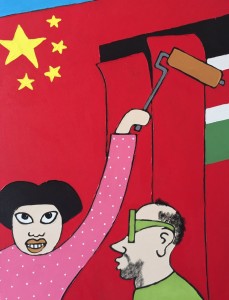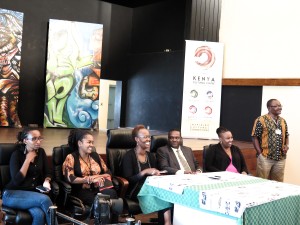
Michael Soi on Venice controversy, 2015.
WHAT IN THE WORLD?
Reconciling the controversy about the ‘Kenyan’ Pavilion at the 56th Venice Biennial
Caught up in the commotion around the ‘Kenyan’ pavilion at the Venice Biennial, the art world is incensed by the news that trickster Armando Tanzini, an Italian with Kenyan citizenship, has duped them again. Having organized what he has craftily branded the Kenyan pavilion at the 56th biennale, the selection of artists is yet again principally Chinese. Tanzini and accomplices pulled a similar scam in 2013, strolling away scot-free.
 Michael Soi on Venice scandal, 2015.
Michael Soi on Venice scandal, 2015.
If this is the first you are hearing of the scandal, yes, you read that right. Absurd as it is, the Kenyan pavilion at this year’s Venice Biennial, commissioned by Italian Paola Poponi and curated by Sandro Orlandi Stagl and deputy curator Ding Xuefeng, features a band of Chinese nationals. The artists include Qin Feng, Shi Jinsong, Li Zhanyang, Lan Zheng Hui and Li Gang, Italian-born artist Armando Tanzini and one Kenyan filmmaker, Yvonne Amolo, who lives in Switzerland.
With the extraordinary flowering of the Kenyan contemporary art scene in recent years, any savvy collector, art aficionado or casual reader of art news in Kenya and overseas would agree that there is a substantial list of talented Kenyan artists whose work would have surely impressed the biennial crowd. Popular Kenyan artist Michael Soi, whose artwork features in numerous international collections, has drawn attention to the controversy through his paintings The Shame in Venice I II and III.
Painted in Soi’s familiar style, using bold charcoal lines and luminous colour, the reactionary series features the Chinese artists fraudulently representing Kenya. The Shame in Venice III, completed on April 19th, is Soi’s latest satirical expression, depicting a Chinese artist masking the Kenyan flag with the Chinese flag while Tanzini watches. Soi speaks for the many Kenyan artists who say the pavilion has nothing to do with Kenya, and should not be branded as such. It seems the art world is holding its breath and hoping that when the 56th Venice biennale opens on May 9, the so-called Kenyan pavilion will have either been renamed or completely withdrawn.
 KCC Press conference Cabinet Secretary Hassan Wario with Art Curator from NMK Lydia Galavu, April 10, 2015.
KCC Press conference Cabinet Secretary Hassan Wario with Art Curator from NMK Lydia Galavu, April 10, 2015.
*In a recent interview with NPR, Tanzini seems to brag to East African correspondent Gregory Warner that if it wasn’t for his efforts there would be no Kenyan pavilion at all. He says that it wasn’t solely his money that went towards the 2015 biennial, but does not say who else contributed. He also admits that he paid hundreds of thousands of dollars to attain the pavilion in 2013. Regarding his participation this year, he said, “Unfortunately, if I want to bring Africa, or Kenya, I must compromise in some way. Compromise because we have no the money.” Tanzini suggests that Kenya does not have the funds to secure a pavilion. Whether or not this true, there is no excuse for the misrepresentation of Kenyan talent at the Biennial.
Determined artists and devotees of the Kenyan arts community cannot bear to be robbed of their identity or post again. So, in the first week of April, Kuona Trust Centre for Visual Arts in Kenya sent an open call to artists, galleries, agencies and other affiliates of the arts, to gather for a roundtable meeting on April 8th and deliberate on a way forward. It was agreed that the primary goal was to ensure that the Kenyan name and flag be removed from Tanzini’s pavilion at the upcoming Venice Biennial.
At the crowded roundtable, an interim board was voted into place to represent Kenyan artists to the Kenyan government ministry. Voted to the board were the acclaimed Kenyan artists Justus Kyalo and Paul Onditi, up-and-comer Wambui Kamiru (an artist from Kuona Trust), General Manager of the Nairobi GoDown Arts Centre Judy Ogana, Director of Kuona Trust Sylvia Gichia, and Art Curator from the National Museums of Kenya Lydia Galavu. The board, accompanied by artists Thom Ogonga and Michael Soi, met with Cabinet Secretary (CS) Dr. Hassan Wario Arero from the Kenyan Ministry of Sports, Culture and the Arts at 9:00am on Friday April 10.
 KCC Press Conference Friday April 10, Wambui Kamiru, artist, Lydia Galavu, art-curator nmk, JudyOgana, Director of GoDown and Dr.Hassan Wario, Arero C.
KCC Press Conference Friday April 10, Wambui Kamiru, artist, Lydia Galavu, art-curator nmk, JudyOgana, Director of GoDown and Dr.Hassan Wario, Arero C.
Emerging cheerfully from the discussion with Dr. Wario, the team was surprised to learn that they had his full support. “Happy to report that we had a very positive and cordial meeting with the Cabinet Secretary and his team this morning,” wrote Sylvia Gichia in an email to the roundtable attendees, “Dr. Wario also made it clear that he is very aware of the current situation at the Venice Biennial and he is willing to help and facilitate in any way possible to fix this highly embarrassing situation.” At a public press conference on April 10th at the Kenya Cultural Center, Dr. Wario confirmed this sentiment and expressed that he would “convene a meeting of stakeholders to discuss the way forward for a truly representative pavilion in 2017.”
Dr. Wario alluded to a fractured art scene, as to somehow excuse the failures of the ministry in allowing the misrepresentation of Kenya. It is true that splintered communication among the art establishment in Kenya has very likely hindered the creation of an objective committee to represent and advocate for Kenyan artists domestically and abroad. Whether it is a disgruntled artist not yet been paid for artwork sold at a museum or and established gallery or agency resenting the success of another, it is the combination of bruised egos, languor and the insatiability of parties accustomed to power that has impeded the course forward.
Delivering a comprehensive government statement that indicated a full understanding of the transgressions at hand, and describing the way forward, Dr. Wario concluded the press conference on April 10th on a high note. He claimed the next step would be to send four separate letters from the Kenyan government, requesting for information and action; one to the Kenyan embassy in Italy, one to the Italian embassy in Kenya, one for the Venice Biennial and one to the self-fulfilling Armando Tanzini himself. Members of the Kenyan art community were told that these went out on Thursday April 16.
So would this be the thunder that finally resolves the wild storm? Mixed reviews were heard among the large group of artists that had gathered at the Kenya Cultural Centre. While some were confident that it would be a case of history on repeat others were satisfied having witnessed the artist community uniting and beginning to move forward together.
“I hope we will be able to make right what we haven’t been able to do in previous biennials,” said Judy Ogana at the conference. “I’d like to think that this is the beginning of a better way forward,” said Silvia Gichia. Of course, there was no word from Tanzini who Dr. Wario felt should not be involved. Dr. Wario implied that Tanzini’s presence offered little value at the conference. And so, having escaped this talk in Nairobi, Tanzini was either shaking in his pants or laughing all the way home.
Though no one wants to hear it presently, the truth is that Armando Tanzini is a talented artist, adept in multiple mediums. He stirs his audience with alfresco sculptures of mystic figurines, enigmatic wildlife, and mythical horses, peculiar and poignant as a result of subtle adaptations in their form. In Malindi on the Kenyan coast, The White Elephant is Tanzini’s extravagant seaside hotel and residence, with a colossal studio and a number of captivating galleries onsite. With soaring centaurs on a central stage and phantom damsels that form the pillars and poles, the establishment is a giant playground for the artist; a mythological wonderland brimming with all of his fantasy creations – complete, incomplete, intact and eroding.
Though Tanzini might be king of his castle at the coast he has certainly lost his popularity on the Kenyan and perhaps global art scene now. He crossed a line by disregarding Kenyan talent, recklessly opting to make a profit and a fool of himself. But as relentless as he was in his mission, it is clear that Tanzini is not the sole perpetrator in this equation. He required the assistance of some big cheeses, either ignorant or corrupt, from one side or another. Given that the board at the Venice Biennial only accepts applications with government or diplomatic approval, there is no doubt he corroborated with a secondary party that overlooked some major infractions.
Are we stuck at the speculation stage? Was it the Chinese artists with a reputation for paying their way into recognized international events to impress local Chinese collectors, or perhaps it was a personal connection between Tanzini and the Biennale, as implied during the April 10th press conference? Could it be someone from the Ministry of Sports, Culture and the Arts in Kenya, the highest point of contact being his honorable Dr. Hassan Wario, who says he does not even know what the application forms look like? The hefty fee to participate in the Venice Biennial certainly came from somewhere. The application paperwork, supposedly accessible to the public, has yet to materialize.
Without any evidence, we definitely can’t point a finger but we did recently gain access to a press office statement from Maria Cristiana Costanzo, Head of Press and Media Relations for Visual Arts and Architecture at the Venice Biennial. She explains to Stefania Ragusa, who wrote requesting an explanation of the calamity. Costanzo explained that Venice Biennale 2015 curator Okwui Enwezor, “has nothing to do with the national participation and he doesn’t make any statement about this.” She writes, “I inform you that it is a Kenyan internal issue.” Costanzo continued her communication with this statement:
“All along the official participation of the countries are managed independently from the countries that forward an official request through governmental or diplomat authorities. The relationship between the Biennial and the single countries is carried out according to principles respectful of the fact that it is about authorities representing sovereign states. About all the other organizational aspect’s related to the participation of the single countries (designation of the curator, the project, the selection’s procedure of the artists, the choice of the venue, etc.). The Biennial doesn’t interfere in any way leaving full autonomy, as a consolidated custom, to the participant country.”
Well then…where does this leave us? Venice appears to have met their side of the bargain, with no more obligations to fulfill. Does this mean that there is a possibility that the ‘Kenyan’ pavilion will retain its label until the end of the biennial on November 22nd? Until the application emerges or we can prove that the submission was corrupted, the Kenyan pavilion is on its way up. The artwork that will be on display is by no means representative of the nation’s current artistic disposition and is a betrayal of what the modern biennale stands for, the honest display of national visual culture.
This is an opinion piece by artist and art writer Zihan Kassam, currently based in Kenya. Kassam attended the Kuona Trust roundtable meeting on April 8th and the KCC press conference with Cabinet Secretary Dr. Hassan Wario Arero on April 10th 2015.
www.zihankassam.com
*Why Are Chinese Artists Representing Kenya At The Venice Biennial?
http://www.npr.org/blogs/goatsandsoda/2015/03/30/396391120/why-are-chinese-artists-representing-kenya-at-the-venice-biennale
